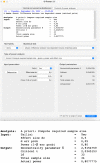Investigation on the effect of antimicrobial photodynamic therapy as an adjunct for management of deep caries lesions-study protocol for a randomized, parallel groups, controlled clinical trial
- PMID: 36870982
- PMCID: PMC9985277
- DOI: 10.1186/s13063-023-07181-8
Investigation on the effect of antimicrobial photodynamic therapy as an adjunct for management of deep caries lesions-study protocol for a randomized, parallel groups, controlled clinical trial
Abstract
Background: Alternatively to conventional treatments, chemo-mechanical caries removal agents can be used. A modality of treatment that has been increasing in dentistry is antimicrobial photodynamic therapy (aPDT). Bixa orellana is being researched for application in aPDT. This protocol aims to determine the effectiveness of aPDT with Bixa orellana extract in deep caries lesions.
Methods: A total of 160 teeth with deep occlusal dental caries will be selected and divided into 4 groups: G1 - control group (Caries removal with a low-speed drill); G2 - Partial Caries Removal with Papacarie™ (Fórmula e Ação, São Paulo, SP, Brazil); G3 - Partial Caries Removal with Papacarie™ and application Bixa orellana extract (20%) (Fórmula e Ação, São Paulo, SP, Brazil); G4 - Partial Caries Removal with Papacarie™ and application Bixa orellana extract (20%) with LED (Valo Cordless Ultradent®, South Jordan, UT, USA) (aPDT). After treatment, all the teeth will be restored with glass ionomer cement and followed up clinically and radiographically, with evaluations at immediately, 1 week, and 1, 3, 6, and 12 months. Dentin samples before and after treatment will be analyzed microbiologically. The efficacy of treatments will be assessed with microbiological (colony-forming units, before and after carious tissue removal), radiographic (integrity of the periapical area and eventual changes in the radiolucent zones), and clinical examinations (retention of the restorative material in the cavity and occurrence of secondary caries), as well as with the time required for the procedures and the need for anesthesia during the procedures. In case data distribution is normal, analysis of variance (ANOVA) will be used for both the dependent and independent variables. In case the data distribution is not normal, the Friedman test will be used for the dependent variables. For independent variables, the Kruskal-Wallis test will be used.
Discussion: Procedures using aPDT have been developed for the treatment of dental caries, but there are few controlled clinical trials in the literature confirming its efficacy.
Trial registration: This protocol is registered at ClinicalTrials.gov under the number NCT05236205 and it was first posted on 01/21/2022 and last updated on 05/10/2022.
Keywords: Bixa orellana; Dental caries; LED; Photodynamic therapy; aPDT.
© 2023. The Author(s).
Conflict of interest statement
The authors declare that they have no competing interests.
Figures



Similar articles
-
Photodynamic therapy with Bixa orellana extract and LED for the reduction of halitosis: study protocol for a randomized, microbiological and clinical trial.Trials. 2018 Oct 29;19(1):590. doi: 10.1186/s13063-018-2913-z. Trials. 2018. PMID: 30373650 Free PMC article.
-
Antimicrobial photodynamic therapy with Bixa orellana extract and blue LED in the reduction of halitosis-A randomized, controlled clinical trial.Photodiagnosis Photodyn Ther. 2020 Jun;30:101751. doi: 10.1016/j.pdpdt.2020.101751. Epub 2020 Apr 12. Photodiagnosis Photodyn Ther. 2020. PMID: 32294559 Clinical Trial.
-
The effect of antimicrobial photodynamic therapy on infected dentin in primary teeth: A randomized controlled clinical trial protocol.Medicine (Baltimore). 2019 Apr;98(15):e15110. doi: 10.1097/MD.0000000000015110. Medicine (Baltimore). 2019. PMID: 30985667 Free PMC article.
-
Does selective caries removal in combination with antimicrobial photodynamic therapy affect the clinical performance of adhesive restorations of primary or permanent teeth? A systematic review with meta-analysis.J Clin Pediatr Dent. 2022 Sep;46(5):1-14. doi: 10.22514/jocpd.2022.002. Epub 2022 Sep 1. J Clin Pediatr Dent. 2022. PMID: 36624909
-
Scientific evidence in antimicrobial photodynamic therapy: An alternative approach for reducing cariogenic bacteria.Photodiagnosis Photodyn Ther. 2019 Jun;26:179-189. doi: 10.1016/j.pdpdt.2019.03.012. Epub 2019 Mar 18. Photodiagnosis Photodyn Ther. 2019. PMID: 30898559 Review.
Cited by
-
Antimicrobial photodynamic therapy against oral biofilm: influencing factors, mechanisms, and combined actions with other strategies.Front Microbiol. 2023 Jun 9;14:1192955. doi: 10.3389/fmicb.2023.1192955. eCollection 2023. Front Microbiol. 2023. PMID: 37362926 Free PMC article. Review.
-
Antimicrobial Efficacy of Chemomechanical Carie Removal Agents-A Systematic Integrative Review.Biomedicines. 2024 Aug 2;12(8):1735. doi: 10.3390/biomedicines12081735. Biomedicines. 2024. PMID: 39200199 Free PMC article. Review.
References
-
- Silva ZS, França CM, Araújo Prates R, Botta SB, Ferrari RAM, Ana PA, et al. The effects of photodynamic therapy with blue light and papain-based gel associated with Urucum, on collagen and fibroblasts: a spectroscopic and cytotoxicity analysis. Lasers Med Sci. 2020;35:767–775. doi: 10.1007/s10103-019-02857-7. - DOI - PMC - PubMed
-
- De Paula GS, Oliveira MC, Sales LS, Boriollo M, Rodrigues LKA, Nobre-dos-Santos M, et al. Antimicrobial photodynamic therapy mediated by methylene blue coupled to β-cyclodextrin reduces early colonizing microorganisms from the oral biofilm. Photodiagn Photodyn Ther. 2021;34:102283. doi: 10.1016/j.pdpdt.2021.102283. - DOI - PubMed
Publication types
MeSH terms
Substances
Associated data
Grants and funding
LinkOut - more resources
Full Text Sources
Medical

